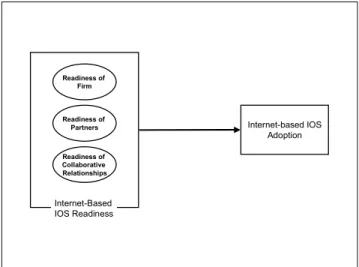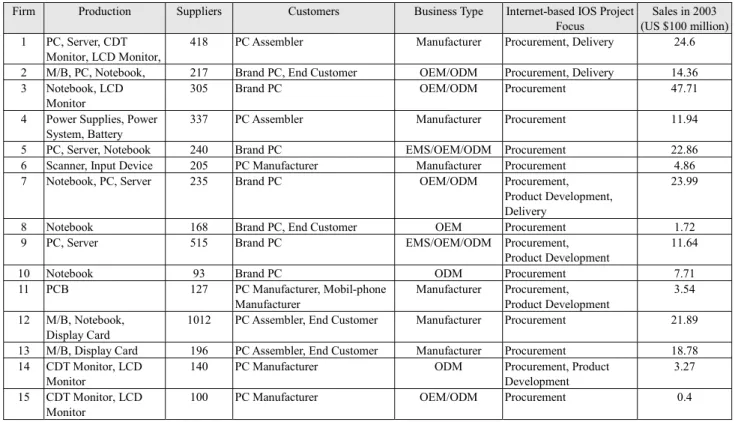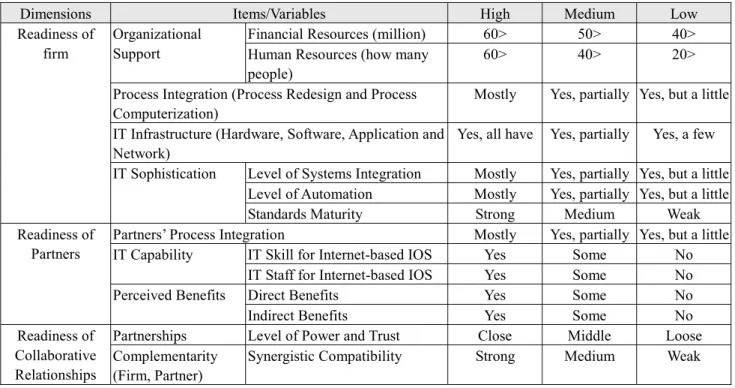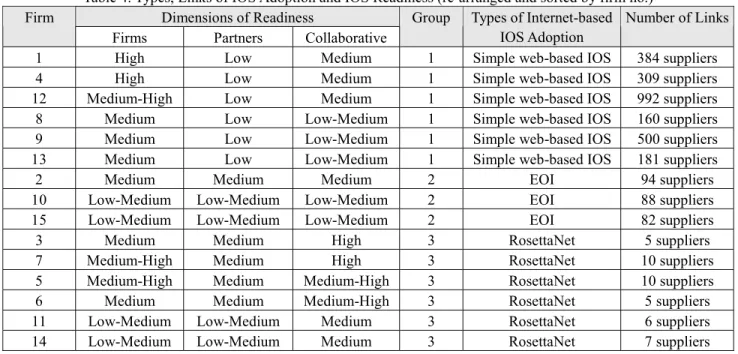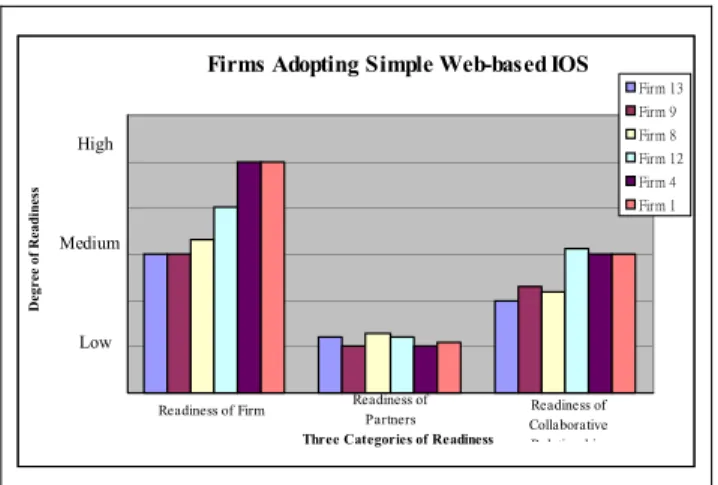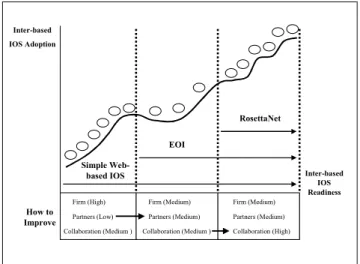Assessing the Readiness of Internet-based IOS and Evaluating its Impact on
Adoption
Hsin-Lu Chang
Shin-Horng Chen
Department of Management Information Systems,
National ChengChi University, Taipei 116, Taiwan
hchang@mis.nccu.edu.tw
shchen@mis.nccu.edu.tw
Abstract
This study explores the readiness factors for the adoption of Internet-based inter-organizational systems (IOS) via a case analysis of fifteen Taiwanese firms. By proposing a three-dimension readiness model (readiness of firm, readiness of partners, and readiness of collaborative relationships), this study extends previous work of IOS adoption to identify critical readiness factors for Internet-based IOS adoption and examines the impacts of these readiness factors on different types of Internet-based IOS adoption, in terms of simple web-based IOS adoption, EOI (EDI on the Internet) adoption, and RosettaNet-based IOS adoption. Three findings are shown in this study: (1) The readiness of firm is an essential condition for all cases, and cases of simple web-based IOS adopters place more focus on firm readiness than other readiness dimensions; (2) EOI adopters places most emphasis on partner readiness, and (3) for the cases of RosettaNet adopters, collaborative relationships is more important than firm readiness and partner readiness.
1.
Introduction
Companies that seek to exploit the benefit and cost advantages through inter-organizational systems (IOS) face a complex strategic decision. They must decide, first and foremost, whether they are ready to adopt IOS. This decision is complicated by the fact that IOS implementation is across organizational boundaries [18] and its success is determined not only by companies but also their partners. The issue is becoming especially important when many companies start to build their IOS on the Internet [29].
However, most of past studies put their focus primarily on the firm-level factors, such as IT infrastructure [18], financial and technological resources [14], and top
management support [12]. Some studies suggest useful research directions on the importance of trading partner readiness [6] and collaborative relationships [16] to IOS success, but never put them together in a manner that examines their joint effects on IOS adoption.
Besides the theoretical concern, while the Internet eases the IOS connection to trading partners, many organizations find that they face even more challenges related to the barriers of inter-organizational factors such as lack of mutual trust and mechanisms for profit sharing. Obviously, the little knowledge on readiness of trading partners and collaborative relationships seriously restrict the values of Internet-based IOS that companies can realize.
Therefore, the objective of this study attempts to develop an integration model for assessing the readiness of Internet-based IOS adoption and evaluating its impact on adoption. We identify three dimensions as the construct of the readiness of Internet-based IOS adoption:
the readiness of firm, the readiness of partners and the readiness of collaborative relationships. A case study
approach is then used to investigate how a set of readiness factors influences the adoption of Internet-based IOS. By examining these readiness factors together in our proposed research model, this study is able to explore their relative influence on Internet-based IOS adoption, thereby providing a guideline for firms pursuing a better performance based on their current adoption status.
The rest of the paper is presented as follows. Section 2 reviews prior research with regard to the adoption of Internet-based IOS. Section 3 illustrates the research model used in this study and explains our research design. The research results and findings are described in section 4. Finally, the discussion and recommendations are proposed in relation to the results and findings of this study in section 5, and the paper concludes in section 6.
Within the last two decades, studies have been conducted to identify possible factors driving IOS adoption [14], [18], [6]. Some studies have focused on the perspective of diffusion of innovations (DOI) [20], looking at technological characteristics (e.g. IT infrastructure, IS/IT sophistication, IT capability) that either encourage or inhibit adoption intention. For instance, Pare and Raymond [17] posit that IT sophistication influences firm’s level of technological expertise (e.g. level of systems integration, level of automation and standards maturity), while Premkumar and Ramamurighy [18] indicate that IOS adoption should be accompanied by necessary IT infrastructure (e.g. hardware, software, application and network).
Another research stream focuses on the perspectives of organizational innovativeness (OI) [27], examining the influence of organizational characteristics on decisions of innovation adoption [9], [12], [18], [8]. For example, Saunders & Clark [21] and Iacovou et al. [14] examine the impact of organizational support on IOS success and find that organizations with financial and human resources available for IT investments are more possible to adopt successfully. Researchers [18], [16], [10] also note the significance of process integration on IOS adoption and posit that organizations with highly integrated, computerized processes are better prepared to undertake IOS projects.
The DOI and OI studies provide the theoretical foundation for the research of IOS adoption. However, the readiness of Internet-based IOS may not be solely based on technological and organizational factors [6]. Based on Soliman & Janz [22], Internet-based IOS is a technology that offers advantages based on the characteristics of the Internet, and appeals to many businesses as an efficient way to link trading partners along the supply chain. Thus, the readiness of trading partners should be a significant dimension to consider while discussing the Internet-based IOS adoption.
Some EDI studies have recognized the significance of trading partner readiness on EDI adoption. For instance, Iacovou et al. [14] identify trading partners’ perceived
benefits, the anticipated advantages that EDI can provide
the trading partners, is a significant factor of IOS adoption. Crook & Kumar [8] recognize the importance of trading partners’ IT capability. They argue that higher level of partners’ necessary skill and staff will offer companies external motivations to proactively take the action for EDI linkages. Yet, Internet-based IOS is distinguished from
EDI in many areas, such as technology architecture and processes handling [19], and thus requires specific trading partner readiness factors. In Angeles & Nath [2] study, they identify partners’ process integration for the adoption of Internet-based EDI (EOI) and posit that having trading partners with high-level process integration, in terms of the number of EOI links, is a necessary condition of Internet-based IOS success.
Besides including the readiness of trading partners on the top of past IOS adoption factors, we propose a new dimension in the Internet-based IOS readiness: the readiness of collaborative relationships, while considering that the adoption of Internet-based technologies requires more tight coordination and cooperation between at least two organizations [29], and thereby the readiness between the organization and its trading partners becomes salient [2]. Although there is no study directly examining the readiness of collaborative relationships on intent to adopt Internet-based IOS, there is some implied evidence showing that collaborative relationships have a positive influence on Internet-based IOS adoption behavior. For example, some recent studies have focused on the role and characteristics of inter-organizational partnerships. They argue that different types of partnerships are related to specific strategic goals, and the role of power and trust in inter-organizational linkages should be of interest to researchers [13], [15], [1], [11]. Other researchers have found that the complementarity between firm and trading partners is highly related with IOS adoption and investment. Their studies point to the impact of inter-firm dyadic relationships on IOS adoption (e.g., [24]).
Consequently, past research on IOS adoption primarily focus on organizational and technological readiness factors (which we summarize as firm readiness). Some studies may notice the trading partner readiness, but very few studies address the readiness of collaborative relationships. Further, there is no single study that has developed a model to study the three dimensions of readiness factors together and examined the interactive and joint effects of these factors on the adoption of Internet-based IOS. Thus, the goal of this research is to jointly consider the impact of firm readiness, partner readiness and relationship readiness on Internet-based IOS adoption, so that we can fully capture the readiness related with Internet-based IOS adoption and provide companies effective adoption strategies for better performance.
Based on the literature review, we define Internet-based IOS readiness is the degree to which a trading network, including the focal firm and their partners, is prepared to adopt and exploit Internet-based IOS. In our research model, there are three dimensions of Internet-based IOS readiness: (1) readiness of Firm, (2) readiness of Partners, and (3) readiness of Collaborative Relationships, that have positive effect on the Internet-based IOS adoption. The research model is shown in Figure 1.
Each dimension is comprised of several variables. The readiness of firm considers the level of
organizational support, process integration, IT
infrastructure, and IT sophistication in firms that initiate
the IOS implementation. The readiness of partners concerns about the impact of partners’ process integration,
IT capability, and perceived benefits on IOS adoption
decisions. At last, the readiness of collaborative relationships takes the partnerships and complementarity into account. We propose that different types of Internet-enabled IOS adoption have different readiness requirement. For instance, the adoption of Internet-based process standards (such as RosettaNet) may need higher
readiness in collaborative relationships than the adoption of Internet-based EDI. We will examine the proposition in the latter sections. The definition of each research variable is described in Table 1. Readiness of Firm Readiness of Partners Readiness of Collaborative Relationships Internet-Based IOS Readiness Internet-based IOS Adoption
Figure 1. Proposed Research Model
Table 1. Definition of Research Variables
Variables Description Sources
Dimensions 1: Readiness of Firm
Ԧ Organizational Support Financial and Human Resources [21], [14], [16], [6] Ԧ Process Integration Level of Firm’s Integrated and Computerized Processes [7]
Ԧ IT Infrastructure Hardware, Software, Application and Network [18], [16], [25] Ԧ IT Sophistication Level of Systems Integration, Level of Automation and
Standards Maturity
[12], [6]
Dimensions 2: Readiness of Partners
Ԧ Partners’ Process Integration Level of Partner’s Integrated and Computerized Processes [4], [14] Ԧ IT Capability Level of Partner’s Necessary IT Skill and Staff [14], [8] Ԧ Perceived Benefits Direct Benefits and Indirect Benefits [14], [25] Dimensions 3: Readiness of Collaborative Relationships
Ԧ Partnerships Trust and Power [13], [1], [11]
Ԧ Complementarity Utility, Opportunism, Resources and Interests [24]
3.1 Research methodology
Case study is particularly well-suited to IS research [3], and is useful to answer “how” and “why” research questions [28]. Therefore, to explore “how” the three readiness dimensions influences Internet-based IOS adoption, the case study is deemed applicable. We follow the multiple-case approach used in Iacovou et al.’s [14], and select 15 dominative Taiwanese PC companies for
analysis.
Taiwan has been a major producer/manufacturer in the global PC industry, ranking fourth in the world in terms of IT output [5]. PC companies in Taiwan have significant need to adopt advanced Internet-based IOS technologies in consortium with domestic suppliers and global buyers for increasing the effectiveness of supply chains. In view of such industrial need, Taiwan Ministry of Economic Affairs (MOEA) started to coordinate with 15 domestic
PC firms to promote an e-business development plan in 1999. From 1999 to 2001, MOEA totally funded two billion NT dollars in these 15 firms and their over 2000 SME partners, and a series of Internet-based IOS projects in different degree of complexity had been pursued. Their experience offers valuable data for understanding the readiness of Internet-based IOS adoption. The characteristics of these 15 firms are summarized in Table 2.
Case data is collected through semi-structured interviews, company archives, and project documents. However, when necessary, telephone interviews with other tracing questions about the firms are conducted to supplement the information gathered. The interview guides primarily include several open questions to enhance the participants’ flexibility in their responses. Each face-to-face interview is about one hour in length, during which interviews are tape recorded, and
hand-written notes are taken for the goal of reliability to minimize the errors and biases in the data collection [28].
These interviewed participants are MIS managers and executive staff directly involved in the Internet-based IOS project. They offer valuable information on how the IOS initiative project is implemented in their firm with their suppliers. To enhance the validity of the data, each summary of the interview is verified by the interviewed staff after the end of each interview session.
Besides the key informants review the draft of the interview, all 15 firms also provide a copy of their project documents or reports. These documents illustrate the details (quantitative data) for the Internet-based IOS project. Combining interviews, company archives, and project documents, this kind of multiple-source data collection seeks to enable triangulation for data integrity [28].
Table 2. Case Characteristics
Firm Production Suppliers Customers Business Type Internet-based IOS Project
Focus
Sales in 2003 (US $100 million)
1 PC, Server, CDT
Monitor, LCD Monitor,
418 PC Assembler Manufacturer Procurement, Delivery 24.6
2 M/B, PC, Notebook, 217 Brand PC, End Customer OEM/ODM Procurement, Delivery 14.36
3 Notebook, LCD
Monitor
305 Brand PC OEM/ODM Procurement 47.71
4 Power Supplies, Power
System, Battery
337 PC Assembler Manufacturer Procurement 11.94
5 PC, Server, Notebook 240 Brand PC EMS/OEM/ODM Procurement 22.86
6 Scanner, Input Device 205 PC Manufacturer Manufacturer Procurement 4.86
7 Notebook, PC, Server 235 Brand PC OEM/ODM Procurement,
Product Development, Delivery
23.99
8 Notebook 168 Brand PC, End Customer OEM Procurement 1.72
9 PC, Server 515 Brand PC EMS/OEM/ODM Procurement,
Product Development
11.64
10 Notebook 93 Brand PC ODM Procurement 7.71
11 PCB 127 PC Manufacturer, Mobil-phone Manufacturer Manufacturer Procurement, Product Development 3.54 12 M/B, Notebook, Display Card
1012 PC Assembler, End Customer Manufacturer Procurement 21.89
13 M/B, Display Card 196 PC Assembler, End Customer Manufacturer Procurement 18.78
14 CDT Monitor, LCD
Monitor
140 PC Manufacturer ODM Procurement, Product
Development
3.27
15 CDT Monitor, LCD
Monitor
100 PC Manufacturer OEM/ODM Procurement 0.4
3.2 Measurement
Multi-item indicators are used for measuring the various research variables. Table 3 provides an illustration of items used for measuring the various constructs. All of the items are measured using qualitative and quantitative data and have three degrees from low-level to high-level.
In the readiness of firm, organizational support is measured using two items that relate to available resources (financial and human resources) of the firm for Internet-based IOS adoption [6]. Process integration, which measures the level of process redesign and computerization in the firm, is assessed using two items based on guidelines provided by Clark and Stoddard [7].
IT infrastructure is measured using four items that assess
the necessary technological infrastructure for Internet-based IOS adoption [18]. Three items are used to measure IT sophistication [12]. A single item measures the standards maturity for Internet-based IOS adoption. Two items measure the level of systems integration and automation with existing information systems that relate to Internet-based IOS implementation.
In the readiness of partners, partners’ process
integration is measured using two items: the level of
partner process redesign and computerization that are concerned in the partner’s firm [14]. IT capability is assessed using the level of necessary skill and staff for Internet-based IOS adoption. The measurement is based on the partner’s perception of its technological capability [8]. Perceived Benefits is evaluated using direct and
indirect benefits items [14]. Direct benefits items measure the perceived extent of reduced costs, increased orders, and information integration; indirect benefits items measure the perceived extent of improved collaborative relationships, improved customer service, and increased operational efficiency.
In the readiness of collaborative relationships, the quality of partnerships is assessed using the level of power and trust within inter-organizational relationships. The items are developed based on guidelines provided by Hart and Sauuders [13]. Complementarity, which measures the synergistic compatibility among firms and partners for Internet-based IOS adoption, is assessed using four items: degree of utility, opportunism, resources, and interests from firm-partner’s perspectives [24].
Table 3. Definition of Measurable Items
Dimensions Items/Variables High Medium Low
Financial Resources (million) 60> 50> 40> Organizational
Support Human Resources (how many people)
60> 40> 20>
Process Integration (Process Redesign and Process Computerization)
Mostly Yes, partially Yes, but a little
IT Infrastructure (Hardware, Software, Application and Network)
Yes, all have Yes, partially Yes, a few
Level of Systems Integration Mostly Yes, partially Yes, but a little Level of Automation Mostly Yes, partially Yes, but a little Readiness of
firm
IT Sophistication
Standards Maturity Strong Medium Weak
Partners’ Process Integration Mostly Yes, partially Yes, but a little IT Skill for Internet-based IOS Yes Some No IT Capability
IT Staff for Internet-based IOS Yes Some No
Direct Benefits Yes Some No
Readiness of Partners
Perceived Benefits
Indirect Benefits Yes Some No
Partnerships Level of Power and Trust Close Middle Loose Readiness of
Collaborative Relationships
Complementarity (Firm, Partner)
Synergistic Compatibility Strong Medium Weak
3.3 Data description
As indicated above, 15 firms have funded by Taiwanese government to initiate certain Internet-based IOS. The systems can be classified by its enabling the degree of inter-firm process automation. From low level to high, they are simple web-based IOS, EDI on the Internet (EOI), and RosettaNet-based IOS. Six of the firms (firm 1, 4, 12, 8, and 9) are adopters of simple web-based IOS. They allow trading partners to exchange white papers, market analysis, production reports, and
more through company’s website, but the inter-firm transaction data is still transferred manually, by such means as phone or fax, and must be manually keyed into the system. Three companies (firm 2, 10, and 15) are adopters of EOI. When data is sent via EOI, it is sometimes incomplete, or includes errors, and thus some human intervention is needed before the transaction is completed.
Six companies (firm 3, 7, 5, 6, 11, and 14) are the adopters of RosettaNet process standards. RosettaNet, launched in 1998, is a non-profit consortium aimed at
developing XML-based open process standards for system-to-system integration. When data is transferred through RosettaNet standards, the need for manual intervention is substantially decreased. Thus, manpower-related costs to verify, acknowledge, and forward messages may be reduced. The technology also allows for process automation over the Internet, eliminating expensive modes of communication such as
phone, fax and traditional EDI.
4.
Results and findings
We use the high-low approach proposed by Iacovou et al. [14] to explore the effects of each readiness factor. The result is presented in Table 4 and a full discussion of the effects of the readiness factors is offered below.
Table 4. Types, Links of IOS Adoption and IOS Readiness (re-arranged and sorted by firm no.) Dimensions of Readiness
Firm
Firms Partners Collaborative
Group Types of Internet-based IOS Adoption
Number of Links
1 High Low Medium 1 Simple web-based IOS 384 suppliers
4 High Low Medium 1 Simple web-based IOS 309 suppliers
12 Medium-High Low Medium 1 Simple web-based IOS 992 suppliers 8 Medium Low Low-Medium 1 Simple web-based IOS 160 suppliers 9 Medium Low Low-Medium 1 Simple web-based IOS 500 suppliers 13 Medium Low Low-Medium 1 Simple web-based IOS 181 suppliers
2 Medium Medium Medium 2 EOI 94 suppliers
10 Low-Medium Low-Medium Low-Medium 2 EOI 88 suppliers
15 Low-Medium Low-Medium Low-Medium 2 EOI 82 suppliers
3 Medium Medium High 3 RosettaNet 5 suppliers
7 Medium-High Medium High 3 RosettaNet 10 suppliers
5 Medium-High Medium Medium-High 3 RosettaNet 10 suppliers
6 Medium Medium Medium-High 3 RosettaNet 5 suppliers
11 Low-Medium Low-Medium Medium 3 RosettaNet 6 suppliers
14 Low-Medium Low-Medium Medium 3 RosettaNet 7 suppliers
4.1 The Effect of Firm Readiness on
Internet-based IOS Adoption
Several observations can be made comparing among the simple web-based IOS adopters, EOI adopters, and RosettaNet adopters. First, all three groups recognize the significance of firm readiness. As shown in Figure 2, 3, and 4, each group of adopters has medium to high firm readiness, indicating that a medium level of firm’s technological capability and organizational resources is a minimum requirement for the development of different types of Internet-based IOS. This finding is consistent with prior IOS research [14], [6] that technology and organizational readiness affect the firm’s ability and intention to adopt IOS.
Second, the importance of firm readiness varies significantly among the three groups. Compared with the other two groups of adopters, the group of simple web-based IOS adopters primarily focuses on the firm readiness, and put relatively less attention on the readiness of partners and collaborative relationships. The
reason could be that firms adopting simple web-based IOS have smaller partners than other types of adopters. These small partners are not aware of the potential benefits of the technology, and they do not have resources and technical capability to implement the complex IOS for the improvement of their operations. Therefore, it is important to note that the group of simple web-based IOS adopters tends to prepare a high firm readiness for assisting their small partners before they can improve other two readiness dimensions. As one senior manager in firm 4 points that, the company has 309 suppliers and about 80% of these suppliers are SMEs. To attract suppliers to do business over the Internet, the company must provide complete functional and easy-link technical systems on the Web to enable the procurement or delivery collaboration. In such situation, they have to well prepare in terms of possessing the required financial resources for IOS development and the IT capability for supporting the existing small partners to implement Internet technologies.
adopters place relatively low emphasis on the firm readiness (see Figure 3 and 4). The possible reason is that both EOI and RosettaNet adoption focus on system-to-system integration to support the sharing of data or process automation. The success of those technologies requires high readiness of partners and the underlying relationships. As a MIS manager in firm 3 refers, “different from partners of simple web-based IOS, EOI and RosettaNet partners play an important role with regard to the inter-firm process innovation. They must be large-size and have sufficient IT capability and resources, and most importantly, they should be our long-term trading partners.”
Therefore, in our research results of 15 firms, achieving a proper level of firm readiness is a basic requirement for Internet-based IOS adoption. However, other dimensions of readiness will be considered while introducing more complicated IOS. We summarize the finding as follows,
Finding 1: The readiness of firm is an essential condition for all cases; among them, the group of simple web-based IOS adopters places more focus on the readiness of firm than the group of EOI adopters and RosettaNet adopters.
Firms Adopting Simple Web-based IOS
Three Categories of Readiness
Deg ree o f Rea d in ess ˙˼̅̀ʳ˄ˆ ˙˼̅̀ʳˌ ˙˼̅̀ʳˋ ˙˼̅̀ʳ˄˅ ˙˼̅̀ʳˇ ˙˼̅̀ʳ˄ High Low Medium
Readiness of Firm Readiness ofPartners Readiness of Collaborative R l ti hi
Figure 2. The readiness of Internet-based IOS for firms adopting simple web-based IOS
4.2 The Effect of Partner Readiness on
Internet-based IOS Adoption
As shown in Figure 3, it indicates that three readiness dimensions are low to medium in the group of EOI adopters. However, compared with the group of simple web–based IOS adopters, EOI adopters express their concerns more about the readiness of partners. As Figure 2 and 3 indicate, firms adopting EOI have higher partners’
readiness than those adopting simple web-based IOS. An IOS project manager in Firm 2 expresses his opinions, “to implement the EOI systems, we have to make sure that most of our partners have recognized the need of IOS and are willing to undertake IOS project with us. Most of our EOI partners are highly IT-capable and have suitable business processes ready for EOI.” Obviously, the most critical concern for EOI adopters may be not only the benefits of technology or external pressure, but also the readiness of trading partners. It makes intuitive sense because the firm’s adoption actions of EOI will depend on the collective actions of other partners [12], [18], [14]. As the CTO in Firm 2 put it, “we certainly need to consider partners’ readiness since the formation of EOI linkages requires a lot of coordination with our trading partners.” Thus, we can conclude that having ready partners is a significant success factor of EOI adoption.
Finding 2: For the cases adopting EOI, they place relatively more focus on the readiness of partners.
Firms Adopting EOI
Three Categories of Readiness
Degree of Read in es s ˙˼̅̀ʳ˄ˈ ˙˼̅̀ʳ˄˃ ˙˼̅̀ʳ˅ High Low Medium
Readiness of Firm Readiness of Partners
Readiness of Collaborative R l i hi
Figure 3. The readiness of Internet-based IOS for firms adopting EOI
4.3 The Effect of Collaborative Relationships
Readiness on Internet-based IOS Adoption
Our cases show that having medium firm readiness and partner readiness is the basic condition for Rosettanet adopters (see Figure 4). In one interview of Firm 7, an IOS project manager points out, RosettaNet system is a complex and highly integrated B2B platform. It involves multiple process integration such as product design, payment, procurement, materials management, logistics, and so on. Most of firms and trading partners don’t have sufficient resources or preparation to establish RosettaNet systems. Therefore, only those firms of large size, high IT capability, and abundant financial resources are the
potential adopters to implement RosettaNet.
In addition, the group of firms adopting RosettaNet has the highest readiness of collaborative relationships compared with other types of IOS adopters, as shown in Figure 2, 3, and 4. It implies that the development of complex and highly integrated systems requires close partnerships and strong complementarity among firms and trading partners. For example, the MIS manager of Firm 5 notes, “the partners would consider to establish RosettaNet process standards with us, because there are strong business relationships we have built over a long time.” With such information, the reason that Rosettanet adopters have high relationships readiness is probably because RosettaNet has a more open and complicated infrastructure than traditional EDI, and thus it requires a tighter and much fair partner relationship to jointly develop the systems and a compatible view in the technology innovation. As a manager points out “both my firm and partners have recognized the value provided by inter-firm process integration. By using RosettaNet, we believe it may make our supply chain processes more effective and competitive.” Another IS senior manager in Firm 5 also notes, “for introducing RosettaNet, we need a highly open communication channel with our trading partners. Maintaining a reciprocal relationship helps us work closely together to create highly integrated supply chains”. We summarize the finding as follows,
Finding 3: For the cases adopting RosettaNet system, they put relatively more focus on the readiness of collaborative relationships than the other two groups of adopters.
Firms Adopting RosettaNet
Three Categories of Readiness
Degree of Read in es s ˙˼̅̀ʳ˄ˇ ˙˼̅̀ʳ˄˃ ˙˼̅̀ʳˉ ˙˼̅̀ʳˈ ˙˼̅̀ʳˊ ˙˼̅̀ʳˆ High Low Medium
Readiness of Firm Readiness of
Partners CollaborativeReadiness of R l i hi
Figure 4. The readiness of Internet-based IOS for firms adopting RosettaNet
5.
Discussion
The analysis of the relationships between readiness and adoption brings to surface the practical concerns: how
to facilitate firms to induce successful Internet-based IOS adoption. There is a need for developing a strategic
roadmap for better adoption outcome. Based on our three findings described above, we propose the following suggestions for various types of Internet-based IOS adopters to assist them in preparing their adoption plans and improving their IOS benefits. The recommendations are summarized in Figure 5 and discussed below.
Inter-based IOS Adoption Inter-based IOS Readiness Simple Web-based IOS EOI RosettaNet Firm (High) Partners (Low) Collaboration (Medium ) Firm (Medium) Partners (Medium) Collaboration (Medium ) Firm (Medium) Partners (Medium) Collaboration (High) How to Improve
Figure 5. Recommendations to Internet-based IOS Readiness and Adoption
Our case study includes three types of Internet-based IOS adoption: adoption of simple web-based IOS, adoption of EOI, and adoption of RosettaNet. Based on the three findings, we attempt to address two issues for each stage: (1) the essential condition for entering the current stage and (2) the determinant condition for going to the next stage.
For adopters of simple web-based IOS, obtaining a high level of firm readiness is an essential condition for adoption (Finding 1). Three ways to improve a company’s firm readiness are suggested in our paper. First is to search for organizational support. Although companies may possess the necessary resources for IOS adoption, they usually lack of a plan to organize IOS investments. Companies must develop a financial and human plan that allocates resources to achieve adoption objectives. Second is to sustain the integration of inter-firm business processes. Companies that have unique processes for managing their supply chains may increase difficulties of process integration. Therefore, it is significant for
companies to identify the necessary changes in core inter-firm processes and offer a flexible enough environment to drive such changes. Third is to develop supportive IT infrastructure and handle the associated sophistication. IT promotion and training need to be considered to offer knowledge for system integration, standards development, and process automation and to overcome possible IT resistance.
After adopting simple web-based IOS, the next question is how companies to improve their readiness of IOS adoption from simple web-based IOS to more complicated Internet-based IOS technologies. Based on our Finding 2, the adopters that have high firm readiness need to improve their partner readiness before adopting EOI. Our study identifies three categories of measures to evaluate partner readiness: partners’ process integration, partners’ perceive benefits, and partners’ IT skills and staffs. These measures can constitute the checklist for companies to evaluate their partner readiness and decide whether to accept EOI. Via the checklist, companies can find differences between target and actual requirements associated with the readiness of partners, in terms of process integration among partners, partner’ perceived benefits, and partner’ IT skill and staff. The difference between the requirements represents a gap of adoption and shows where companies need to overcome for entering the EOI stage. For instance, companies can provide promotion programs to help partners perceive the benefits derived from EOI. Subsidies such as training, on-site assistance, and financial resources can be offered to facilitate the development of EOI connections.
Similarly, companies could improve their IOS adoption from EOI to RosettaNet. Based on our Finding 3, the readiness of partners and the readiness of collaborative relationships are the determinant conditions for RosettaNet adoption. Further, the readiness factors of collaborative relationships (such as trust, power, and compliementarity) distinguish the RosettaNet adopters from EOI adopters. Therefore, companies can increase their RosettaNet adoption chance by improving the trust and peer interest of trading partners and choosing the partners who are more complimentary in processes, technologies, and cultures.
6.
Conclusion
This study identifies the readiness of firm, partners, and collaborative relationships and explores their relationships to the adoption mode of the firm. Data
analysis revealed that Internet-based IOS adoption requires not only high firm readiness, but also high partner readiness and collaborative relationships readiness. For instance, EOI adopters put more focus on partner readiness than adopters of simple web-based IOS; on the other hand, RosettaNet adopters emphasize more on relationship readiness than EOI adopters. Consequently, we recommend that companies adopting different type of Internet-based IOS should implement different strategies to improve their readiness. EOI adopters can improve their readiness of collaborative relationships to enhance their chances of adopting RosettaNet. Adopters of simple web-based IOS can improve their partnerships and collaborative relationships for adopting more complicated IOS such as EOI and RosettaNet.
Our contribution lies in three areas, (1) constructing a preliminary metrics to measure the readiness of Internet-based IOS adoption from the perspectives of firms, partners and collaborative relationships, (2) developing a research model that investigates the impact of Internet-based IOS readiness on different types of IOS adoption, in terms of simple web-based IOS, EOI, and RosettaNet-based IOS, and (3) providing a strategic roadmap to induce successful Internet-based IOS adoption and to improve the values for participants. The research model can be further verified by cross-industry case studies and general surveys in the future.
Reference
[1] Allen, D.K., D. Collgan, A. Finnie, and T. Kern, 2000, Ϙ Trust, Power and Interorganizational Information Systems: The Case of the Electronic Trading Community TransLease.ϙ Information
Systems Journal 10Κ21-40.
[2] Angeles, R. and R. Nath, 2000,ಯAn Empirical Study of EDI Trading Partner Selection Criteria in Customer-Supplier Relationships.ರInformation and
Management 37᧶241-255.
[3] Benbasat, I., D.K. Goldstein, and M. Mead, 1987, ಯ The Case Research Strategy in Studies of Information Systems.ರ MIS Quarterly 11(3) ᧶ 369-386.
[4] Bergeron, F. and L. Raymond, 1992, Ϙ The Advantages of Electronic Data Interchange.ϙ
Database 23(4)Κ19-31.
[5] Chen, Tain-Jy, 2003,ϘE-Commerce to Protect the Network Relationships: The Case of Taiwan’s PC Industry.ϙThe Information Society 19Κ59-67.
[6] Chwelos, P., I. Benbasat, and A.S. Dexter, 2001, Ϙ Research Report: Empirical Test of an EDI Adoption Model.ϙInformation Systems Research 12(3)Κ304-321.
[7] Clark, T.H. and D.B. Stoddard, 1996, ϘInterorganizational Business Process Redesign: Merging Technological and Process Innovation.ϙ
Journal of Management Information Systems
13(2)Κ9-28.
[8] Crook, C.W. and R.L. Kumar, 1998,ϘElectronic Data Interchange: A Multi-Industry Investigation Using Grounded Theory. ϙ Information and
Management 34Κ75-89.
[9] Damanpour, F., 1992, Ϙ Organizational Size and Innovation.ϙOrganization Studies 13(3)Κ375-402. [10] Farhoomand, A.F., Tuunainen, V.K., and Yee, L.W., 2000,ϘBarriers to Global Electronic Commerce: A Cross-country Study of Hong Kong and Finland.ϙ
Journal of Organizational Computing and
Electronic Commerce 10(1)Κ23-48.
[11] Gallivan, M.J. and G. Depledge, 2003, Ϙ Trust, Control and the Role of Interorganizational Systems in Electronic Partnerships.ϙInformation Systems
Journal 13Κ159-190.
[12] Grover, V., 1993,ϘAn Empirically Derived Model for the Adoption of Customer-based Interorganizational Systems.ϙ Decision Sciences 24(3)Κ603-640.
[13] Hart, P. and C. Saunders, 1997,ϘPower and Trust: Critical Factors in the Adoption and Use of Electronic Data Interchange. ϙ Information
Systems Research 8Κ23-42.
[14] Iacovou, Charalambos L., I. Benbasat, and A.S. Dexter, 1995,Ϙ Electronic Data Interchange and Small Organizations: Adoption and Impact of Technology.ϙMIS Quarterly 19(4)Κ465-485. [15] Kumar, K., H.G. van Dissel, P. Bielli, 1998,ϘThe
Merchant of Prato-revisited: Toward a Third Rationality of Information Systems. ϙ MIS
Quarterly 22(2)Κ199-226.
[16] Kumar, R.L. and C.W. Crook, 1999, Ϙ A Multi-Disciplinary Framework for the Management of Inter-Organizational Systems.ϙ Database for
Advances in Information Systems 30(1)Κ22-37. [17] Pare, G. and L. Raymond, 1991,ϘMeasurement of
Information Technology Sophistication in SMEs.ϙ Paper presented at the Proceedings of Administrative Sciences Association of Canada Nineteenth Annual Conference, Niagara Falls, Ont.,
Canada, pp.90-101.
[18] Premkumar, G. and K. Ramamurthy, 1995,ϘThe Role of Interorganizational and Organizational Factors on the Decision Mode for Adoption of Interorganizational Systems.ϙ Decision Sciences 26(3)Κ303-336.
[19] Reimers, K., 2001, Ϙ Standardizing the New E-Business Platform: Learning From the EDI Experience.ϙElectronic Markets 11(4)Κ231-237. [20] Rogers, E.M., 1995, Diffusion of Innovation, Free
Press, New York.
[21] Saunders, C. and S. Clark, 1992,ϘEDI adoption and Implementation: A Foucs on Interorganizational Linkages.ϙ Information Resources Management
Journal 5(1)Κ9-19.
[22] Soliman, K.S. and B.D. Janz, 2004,ಯAn Exploratory Study to Identify the Critical Factors Affecting the Decision to Establish Internet-based Interorganizational Information Systems. ರ
Information and Management 41᧶697-706.
[23] Swatman, P.M.C. and P.A. Swatman, 1992,ϘEDI System Integration: A Definition and Literature Survey.ϙInformation Society 8(3)Κ169-205. [24] Tan, M.T.K. and K.S. Raman, 2002,
ϘInterorganizational Systems and Transformation of Interorganizational Relationships: A Relational Perspective.ϙ Paper presented at the Twenty-Third International Conference on Information Systems. [25] Teo, H.H., K.K. Wei, and I. Benbasat, 2003,
ϘPredicting Intention to Adopt Interorganizational Linkages: An Institutional Perspective. ϙ MIS
Quarterly 27(1)Κ19-49.
[26] Truman, G.E., 2000, Ϙ Integration in Electronic Exchange Environments. ϙ Journal of
Management Information Systems 13(4)Κ139-166.
[27] Wolfe, R.A., 1994, Ϙ Organizational Innovation: Review, Critique and Suggested Research Directions.ϙ Journal of Management Studies 31(3)Κ405-431.
[28] Yin, R.K., 1994, Case Study Research᧶Design and Methods, Sage Publications.
[29] Zhu, K., K. Kraemer, and S. Xu, 2003,ಯElectronic Business Adoption by European Firms: A Cross-country Assessment of the Facilitators and Inhibitors. ರ European Journal of Information
